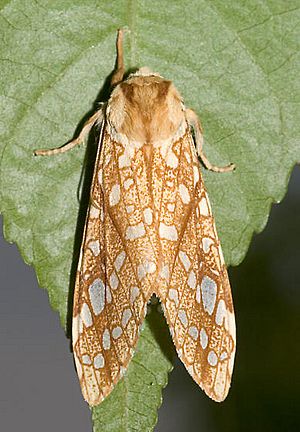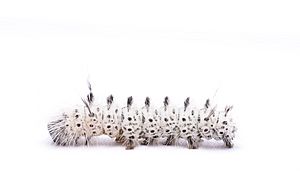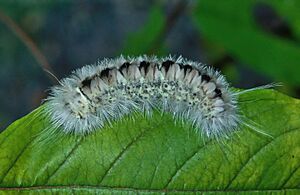Hickory tiger moth facts for kids
Quick facts for kids Hickory tiger moth |
|
|---|---|
 |
|
| Scientific classification | |
| Genus: |
Lophocampa
|
| Species: |
caryae
|
| Synonyms | |
|
Halysidota caryae |
|
The hickory tiger moth (scientific name: Lophocampa caryae) is a cool insect found in the eastern parts of North America. You might also hear it called the hickory tussock moth. It's part of a group of moths known as tiger moths. While some moths in this family can be a bit toxic, the hickory tiger moth is mostly known for its fuzzy caterpillars, which can cause an itchy rash if you touch them.
Life Cycle of the Hickory Tiger Moth
This moth usually has one generation each year. This means the whole life cycle, from egg to adult moth, happens once a year.
The Caterpillar Stage
The larva, which is the caterpillar, is covered in long, hair-like bristles called setae. Most of these hairs are white. However, there are black tufts of hair along the middle of its back. It also has four long black "hair pencils," two near its head and two near its tail. You'll see black spots along its sides, and its head is black.
Touching these hairs can cause an itchy rash for many people. It's a bit like touching certain plants that cause skin irritation. The hairs have tiny barbs, and it's important not to get them in your eyes. If that happens, it's best to tell an adult. Usually, any rash goes away within a day.
Young caterpillars, called early-instar caterpillars, are seen from July to October. They live and eat in groups of about 100. They munch on leaves, eating away the soft parts and leaving just the veins. As they get older, they become solitary, meaning they live alone. These older caterpillars can grow up to 4.5 centimeters long before they change into a pupa.
Hickory tiger moth caterpillars mostly eat the leaves of hickory, pecan, and walnut trees. But they will also eat leaves from trees like ash, elm, oak, and willow. Sometimes, a lot of caterpillars might eat many leaves from nut trees in one area. However, this usually doesn't last long enough to cause serious damage to the trees.
The Pupa Stage
The caterpillar builds a loose cocoon to protect itself during the pupa stage. It weaves some of its own hairs into the cocoon. The cocoon stays hidden in fallen leaves on the ground during the winter.
The Adult Moth
The adult hickory tiger moth flies around in May and June. Its front wings are yellowish-brown with white blotches. These patterns can look a bit like stained glass. The back wings are mostly white. The moth's body is hairy and light brown.



